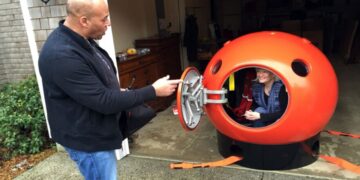What is the most read news of the last week? What have been the trending topics in the world of innovation? What has been talked about on social networks around the world? To answer these questions, we have selected the news that, in the last week, had the most visibility on our portal and have access to the curiosity of our readers. The most read news concerns the Perseverance probe but there are also interesting articles for robotics and computer science enthusiasts.
The most read news of the last week
NASA launches the probe Perseverance to search for signs of life on Mars
 A new chapter in the race to Mars. At 1.50 pm (Italian time) the space probe Perseverance was launched from the NASA base at Cape Canaveral. The takeoff is part of the Mars 2020 mission with which the American Space Agency intends to search (and hopefully find) traces of life on the surface of Mars. Perseverance should reach the orbit of the Red Planet by the end of the year and land on the Martian surface on February 18, 2021. From that date, the Rover present in the probe will begin the exploration of the Mars surface and will collect samples to bring back (in the future) to Earth. NASA administrator Jim Bridenstine said that “this is the first time in history that NASA has dedicated a mission dedicated to what we call astrobiology, the search for life”.
A new chapter in the race to Mars. At 1.50 pm (Italian time) the space probe Perseverance was launched from the NASA base at Cape Canaveral. The takeoff is part of the Mars 2020 mission with which the American Space Agency intends to search (and hopefully find) traces of life on the surface of Mars. Perseverance should reach the orbit of the Red Planet by the end of the year and land on the Martian surface on February 18, 2021. From that date, the Rover present in the probe will begin the exploration of the Mars surface and will collect samples to bring back (in the future) to Earth. NASA administrator Jim Bridenstine said that “this is the first time in history that NASA has dedicated a mission dedicated to what we call astrobiology, the search for life”.
 Even the mask becomes smart. After the economic boom and “popularity” caused by the Coronavirus emergency, many projects dedicated to Personal Protection Devices have sprung up around the world. One of the most innovative and interesting comes from Japan. Donut Robotics – a Japanese startup specialized in robotics – has designed and developed C-Face, an intelligent mask that, in addition to protecting, facilitates communication. In what way? By simultaneously translating the words spoken by the wearer. The mask is equipped with an electronic core that connects via Bluetooth to the smartphone. In this way, C-Face allows you to make calls, amplify your voice, transcribe the words spoken and translate them into nine different languages: Japanese, Chinese, English, French, Indonesian, Korean, Spanish, Thai and Vietnamese.
Even the mask becomes smart. After the economic boom and “popularity” caused by the Coronavirus emergency, many projects dedicated to Personal Protection Devices have sprung up around the world. One of the most innovative and interesting comes from Japan. Donut Robotics – a Japanese startup specialized in robotics – has designed and developed C-Face, an intelligent mask that, in addition to protecting, facilitates communication. In what way? By simultaneously translating the words spoken by the wearer. The mask is equipped with an electronic core that connects via Bluetooth to the smartphone. In this way, C-Face allows you to make calls, amplify your voice, transcribe the words spoken and translate them into nine different languages: Japanese, Chinese, English, French, Indonesian, Korean, Spanish, Thai and Vietnamese.
An archive at the North Pole will save all of humanity’s software
 In a millennium, what will be left of our society? This question has always tormented the human race and every civilization has tried to perpetuate its memory through art, literature or monuments. Today, some of the most important testimonies of our society are intangible. We are talking, of course, about software, programming languages and digital data. But even these “objects” need care and attention to be handed down to posterity. For this reason, the developers of the GitHub platform have built a huge archive in Svalbard Islands, near the North Pole. It is a true “ark of humanity’s software” capable of withstanding natural disasters, wars and pandemics. The software and computer languages are stored on 186 ultra-resistant microfilm. The media are, in turn, stored inside a safe surrounded by steel walls in an old coal mine 250 metres below the surface of the North Pole.
In a millennium, what will be left of our society? This question has always tormented the human race and every civilization has tried to perpetuate its memory through art, literature or monuments. Today, some of the most important testimonies of our society are intangible. We are talking, of course, about software, programming languages and digital data. But even these “objects” need care and attention to be handed down to posterity. For this reason, the developers of the GitHub platform have built a huge archive in Svalbard Islands, near the North Pole. It is a true “ark of humanity’s software” capable of withstanding natural disasters, wars and pandemics. The software and computer languages are stored on 186 ultra-resistant microfilm. The media are, in turn, stored inside a safe surrounded by steel walls in an old coal mine 250 metres below the surface of the North Pole.


































